| Date: 1944 Mar 06/06 | A/C Type: B-24 H Liberator | SN: 42-52226 | Code: E8 - E | A/C Nickname: | 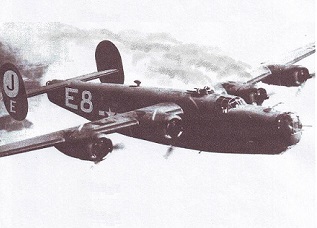 |
|||||
| File: 292 | Airforce: USAAF | Sqn/Unit: 453 BG - 734 BS | Mission/Raid: Genshagen S of Berlin | |||||||
| 1 | Pilot | 1Lt. Hubert R. Cripe (VD67) POW | 9 | RWG | S/Sgt Thomas W. Keefe | |||||
| 2 | Co-pilot | 2Lt. Russell A. Anderson (VD67) POW | 10 | TG | S/Sgt Jason H. McGue | |||||
| 3 | Nav. | 2Lt. Homer 'Spike' W. Dallacqua (VD106) POW | 11 | |||||||
| 4 | B | 2Lt. Maurice A. Dinneen | 12 | |||||||
| 5 | E | T/Sgt Mack O. Garrett | 13 | |||||||
| 6 | RO | T/Sgt Wiliam S. Chapell Jr | 14 | |||||||
| 7 | BTG | S/Sgt Gerald B. Yoder | 15 | |||||||
| 8 | LWG | S/Sgt Albert H. Edgett | 16 | |||||||
On return from Berlin stayed behind formation to help a straggler. Over Dümmer Lake attacked from behind by two Me-109s and damaged with left wing on fire. After some time, crew had to jump from the burning aircraft. This was high above the clouds. They all went into Lake IJsselmeer (Old Zuyder Sea) off Edam, Holland. Only the last three men jumped were closest to fishing boats and were rescued. Seven men drowned in the ice cold water. |
||||||||||
Two fishing boats from village Volendam (Holland) had rescued three unknown airmen from the water of the Zuyder Sea on a cold winter's day in 1944. A German patrol boat took the men over after which they became POW. It remained unknown who the pilots had been. The case was unsuccesfully researched by the USAAF in 1947 and by the Royal Netherlands Air Force in 1965. In 2009 the puzzle could finally be solved. The fishing boats were the VD67 and the VD106 and the aircraft was USAAF B-24 Liberator 42-52229, piloted by 1Lt. Hubert R. Cripe, 453 Bomb Group ( J in white circle), 734 Bomb Squadron (E8) and the fifth aircraft in the Squadron (E).
.
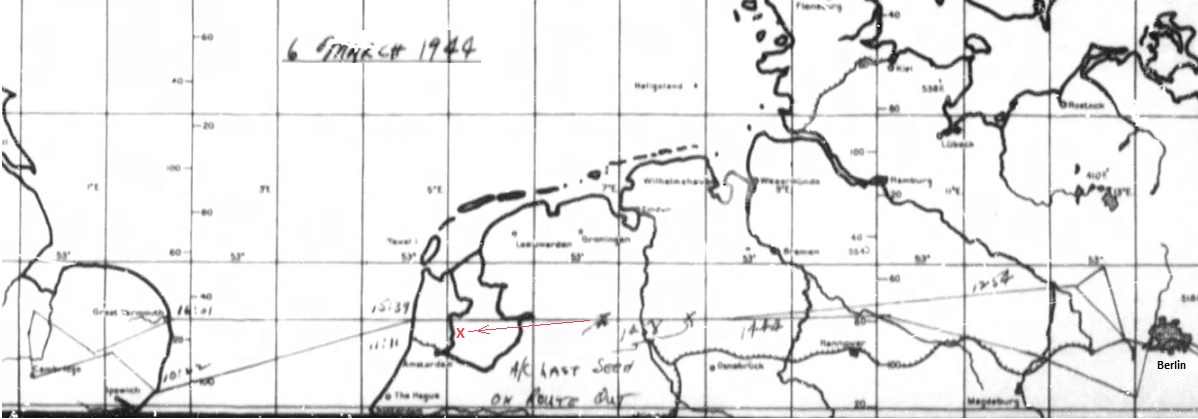
Below 1Lt. Hubert R. Cripe. Photo as cadet, photo as POW (24 years old) and photo during an interview in his house in Astoria, IL, 2010, age 90. At the moment (March 2017) Mr. Cripe is 96. The text on the Prisoner Of War photo reads: KgF. Lg. d. Lw. I = Kriegsgefangenen Lager der Luftwaffe I, better known as Stammlager (Stalag) Luft 1 in Barth. Post scriptum: Mr. Cripe passed away February 20, 2018, age 97.

Lt. Cripe spent 14 months in German captivity. In 1944, while in Stalag Luft 1 Barth, he handwrote a detailed account of his last mission in a book that had some extra blank pages. The book was provided to the POWs by the YMCA. This book was preserved and became the basis of his autobiography 'Bittersweet Brutality'. The story was edited by Mr. Ken Stevens under title 'The Rough Edges', which is on the website of the 453 BG. Thanks to 'The Rough Edges' we could match Mr. Cripe to the story of the Volendam fishermen (our grandfathers). With a message left on the 453 BG website and thanks to Mrs. Tina Fleming, we came in contact with Mr. Cripe.
Lt. Cripe's account of the Berlin trip, 6 March 1944:
"6 March 1944. Was waked at 03:00h. One of the first daylight raids on Berlin. Every B-24 was heavily loaded for the distant trip; ten 600 lbs (in total 2700 kg) bombs, 2700 gallons of gas (10.200 liter), our ten men crew, machineguns and ammo, in total nearly 32 tonnes. The sky was filled with aircraft. The B-17s were in front. We of the 2nd Division with our B-24 were in the back. The stream of aircraft looked like a falanx, 15 miles wide and 100 miles long. Above us was our escort, P-47 Thunderbolts, later P-38 Lightnings and over Berlin our P-51 Mustangs. Target was the Genshagen Daimler Benz engine plant. 'Berlin, here we come!'.
Near Berlin Jerry had the welcome mat turned upside down and inside the door... They put up a Flak barrage, the most concentrated Flak I had ever seen. Some 300 German guns fired concentrated in a box that we had to fly through. It was a terrifying big black cloud with exploding shells, visible 50 miles away. Between the Flak we dropped our bombs and turned away.
It was busy in the air and I switched to a lower position, next to Lt. Tobin who had an engine out. He was slower, but I stayed with him. This was in hindsight maybe not a good decision, but at the time it seemed best because teamed-up we had a better chance against German fighters. In the Dümmer Lake area, two Me-109s attacked us from behind and in front of me they banked away gracefully to the left. Tobin had a gaping hole in his wing and was going down. I asked for help on the radio and a cool Texas voice said: "don't get excited sonny, poppa is coming". His flight of P-47 chased the Germans away.
A fierce burning hole was in my left wing. The German fighter had shot a cannon shell through an almost empty gas wing tank. Near the Dutch border I dived to get the fire out, but no success. I levelled out just above the thick clouds, but the fire was still burning and getting much worse. We could not make it over the North Sea back to England. Some time later I had to order the crew to parachute out. Lt. Dineen jumped through the nose wheel hatch. Spike Dallacqua smiled, waved and disappeared. My co-pilot Russ Anderson came from his chair and we walked to the bomb bay, gave each other a hand and jumped. Floating in the air I heard the plane crash. Under the clouds I saw the big monsterous Lake Zuyder Sea. A piece of my aircraft lay burning on the water. Counted seven parachutes including my own, don't know what happened to the other three (seven dead were later recovered). On the water below were objects I took to be fishing boats.
Drowning.
Suddenly the water seemed close and I tried to unfasten my chute and slip out but was too late. Hit the water hard, it was freezing cold (ice had just melted). I went under and tread myself up once or twice. Tried to get rid of the parachute but could not get it off. Tried to jerk the cord to inflate my Mae West life-preserver but missed and missed again. I was drowning... God must have heard my silent prayer and saved my life. He put my hand on the valve of the carbon dioxide bottle (CO2) that instantly filled one side of my vest and kept my head above water. I rested, released my chute which was entangled around one leg".
Photo below. Crash position off Edam, 6 March 2010, ice just melted.
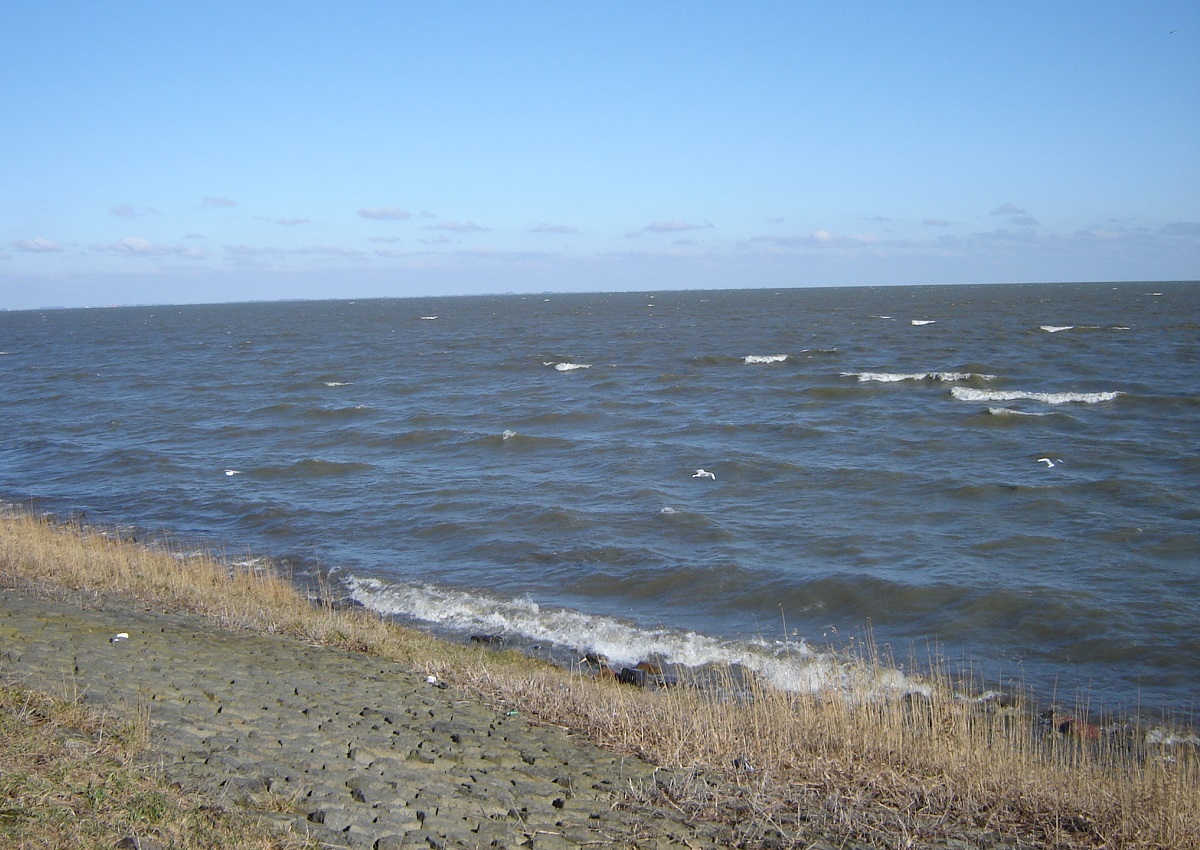
German military presence on the Lake (Lake IJsselmeer a.k.a. old Zuyder Sea).
The Germans patrolled the Lake with armed patrol boats. They had larger boats with medium Flak, operated by their Navy (Kriegsmarine) and smaller, faster boats used by the German Water Police (Wasserschützpolizei) with light Flak (20mm). The Police flotilla stood under direct command of SS General Hanns Albin Rauter, the leader of the SS in the Netherlands. In 1944, hardly any regular German policemen were left on these boats, most were replaced by brutal Waffen-SS volunteers. Allied airmen were hated by them because of the bombing of German cities. Each afternoon after a raid on Germany, these in fact SS-boats were waiting on the Lake to target low flying American stragglers that tried to make it back to England. The fishermen were told not to interfere in any way.
On board fishing boat VD67, 6 March 1944.
Interview with an eyewitness on board; then 14 year old Klaas Kwakman ('Klaas Drop'). Klaas is sitting in his armchair on below photo. Unfortunally Klaas passed away 23 February 2018, age 87.
Klaas: "We were on board the VD67 with my father Jaap 'Bol' Kwakman (the skipper) and his youngest brother Klaas Kwakman ('Klaas Bol'), myself as deckhand. Underneath photo, left to right: my father Jaap eating cooked eels and potatoes, dipping them in the traditional butter & vinager gravy ('Butter & Eek'). Eating with him is Albert Koning, he was not on board March 6. In center image is my uncle Klaas Bol, sorting live eels on size. Right: myself, Klaas Drop" (notice the net-repair tool fixed to the table).
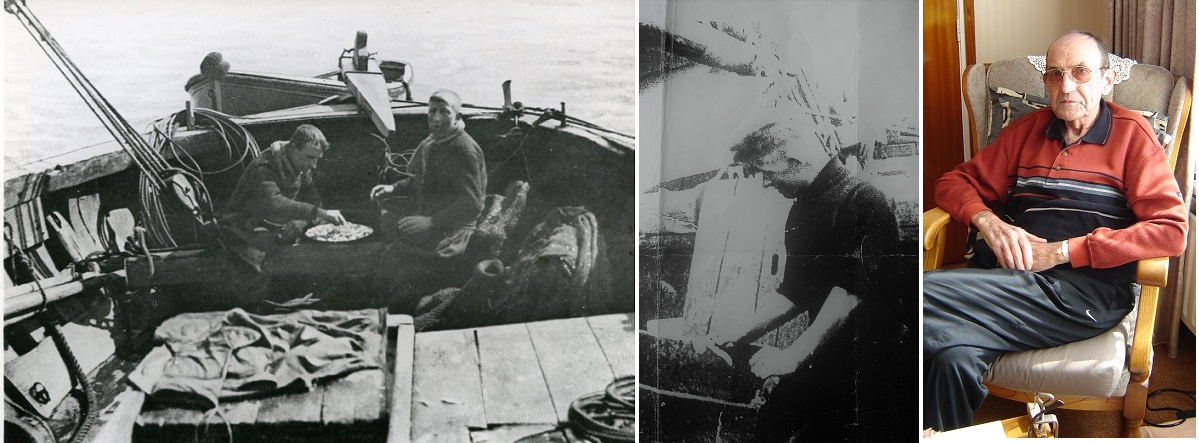
Eyewitness Klaas Drop (then 14):
"We were sailing back to Volendam and were northeast of Edam. Suddenly a burning aircraft came through the thick overcast and dove in the water. Minutes later followed by a row of parachutes. The men that had jumped first were further away to the East, but the last were not far. 'Let's go there!', said my uncle Klaas Bol, but my father Jaap who was the boat owner and skipper hesitated. He was older, wiser and afraid for the German repercussions. Jaap had eight young children to feed and Klaas four. They got in a short argument after which Jaap demonstrative handed over the helm to Klaas, warning him. Jaap looked at the sky and mumbled to God. Klaas started the engine and turned in eastern direction. After a few minutes we pulled out one airman, followed by another. In the distance we saw that the VD106 had got one too. We steamed on and looked for the others, but they all had gone under. The two airmen we took on board were freezing. Under deck my father and Klaas Bol got them into some dry clothes and I steared for Volendam harbor fast. Intention was to hand them over to resistance leader Hein Schilder 'Madoet' who lived in the first house in the harbor, but after a while a fast moving German water police boat came after us, we however maintained speed and course. After a while they signalled us by horn to stop, better was not to ignore this, my father said to stop. The Germans were angry. In the harbor my father and my uncle Klaas Bol were arrested". This story continues further below this page.
Hubert Cripe:
"There was a fishing boat about a 1/4 mile of where I landed. They started the motor. Russ Anderson had landed about 100 yards from me. The boat pulled alongside and took him aboard. I swum to the side and was pulled in by the Dutchmen also. Russ and I embraced each other, thankful to be alive. 'Drink?' said the kind fisherman. Nothing bashful about us, expecting Schnapps, but no, it was water! We had half the Zuyder Sea inside us and they gave us water... Anyhow, they looked very helpful in getting us back to England, I think, but a German harbor patrol launch pulled alongside and took us on board. In their cabin was our navigator Lt. Dallacqua (what's in a name). He was also rescued from the water. We three proved to be the only survivors of crew 44".
A board the VD106, "Get a dry rope!". Lt. Homer 'Spike' Dallacqua.
Interview with eyewitness on board the VD106, Mr. Hans Hes. Then age 17:
Hans: "we were the trawl-mate of the VD67 (two ships trawling one big net in between them), both skippers were also brothers-in-law. Four of us were on the VD106: skipper Klaas Klouwer ("Claus van Janke") and experienced older fisherman Sijmen (Simon) van de Loos. I was young and combined with Klaas' son Jan Klouwer ("Jan Prent") we made the third full man on board. On below photo you see skipper Klaas on his back handling two 50 pound weights, his son Jan and Sijmen working on the winch to haul the trawl net in. I am not in this picture".
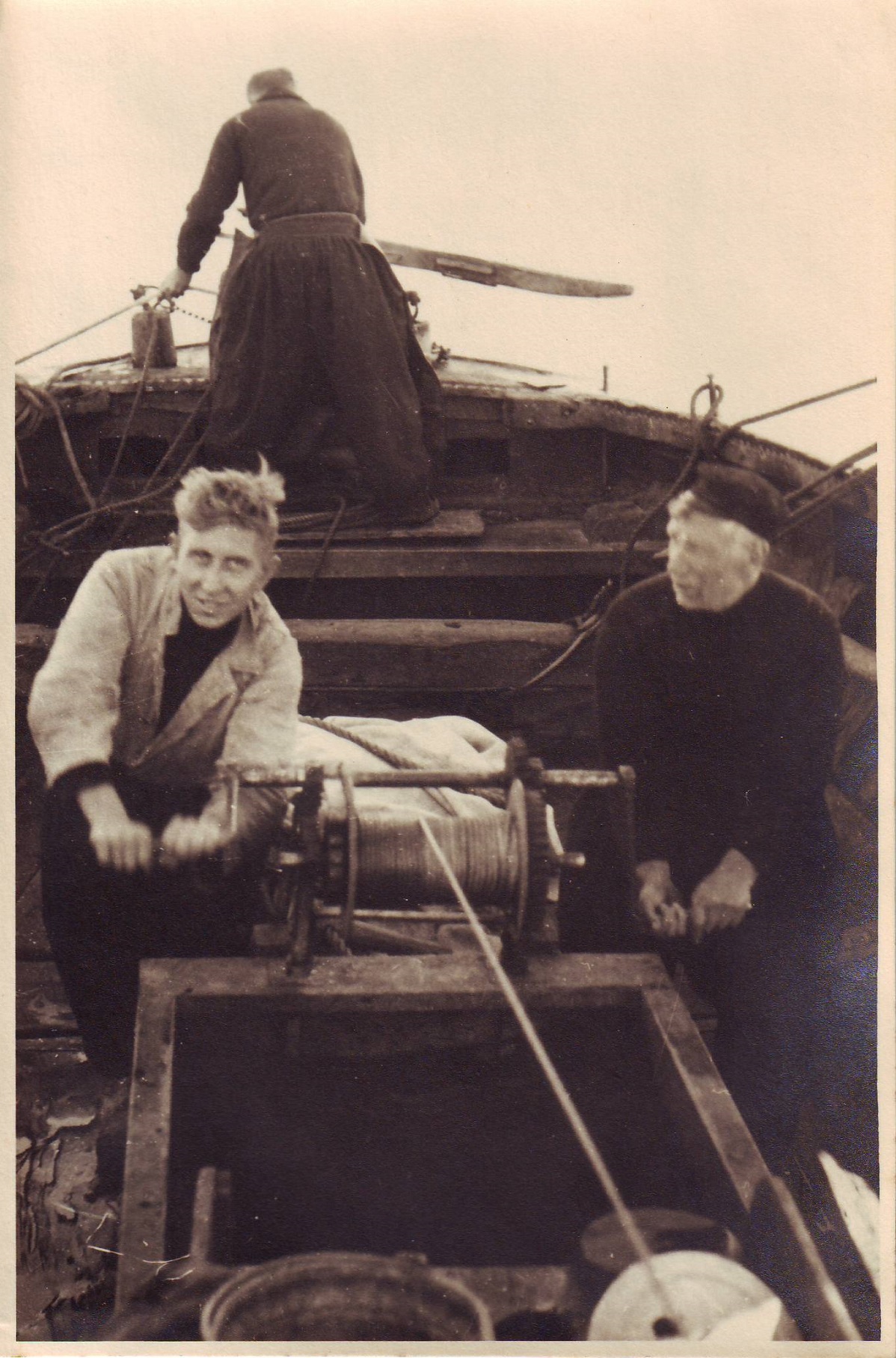
Eyewitness Hans Kes on the VD106 (then age 17:) and the rescue of navigator 2Lt. Homer 'Spike' Dallacqua:
"We saw a row of parachutes coming down. We turned to portside, heading fast for the nearest in the water, knowing that he would not last longer than a few minutes in the ice cold water. By the time we got to him, we had gained a lot of speed because we were under full sail with wind broad reach. Stopping was not possible. "Get a dry rope!", shouted Sijmen to me. As fast as I could I went underdecks to get a new dry rope and handed it to Sijmen. A dry rope could be casted much further than an old wet deck rope. From great distance Sijmen threw the end of the rope exactly between thumb and index finger of the airman in the water. The drowning man made a clever move: he rolled the rope twice under his armpits over his chest. Our ship could not stop and passed him fast. When the rope was streched fully, the man was jolted towards us with huge force! He lay almost on our deck! Problem was that he was not moving and was unconscious".
"Another fishing boat came nearer. They shouted that we should apply CPR on him. The method of CPR was then not as today. We simply lay him on his back and made an up and down water-pumping motion with his arms. He gulfed water from his mouth and came back to life. The man was very thankful and gave as gift his wallet packed with money to skipper Claus. After a short while a German patrol boat came alongside us to take the airman over. The German officer shouted angry to us that 'the rescuing of Allied pilots was exclusively a job reserved for the German Wehrmacht!' (...). He calmed down when we kept quiet and acted stupid. Our skipper was afraid to keep the wallet and gave it to the German officer, who then went in pursuit of the VD67".
Photo below. Obituary of skipper Klaas Janszoon Klouwer (Claus van Janke) in 1951 and eyewitness Mr. Hans Kes (ret. accountant) in 2009, age 82. Hans passed away 15 Sept. 2020, age 92.
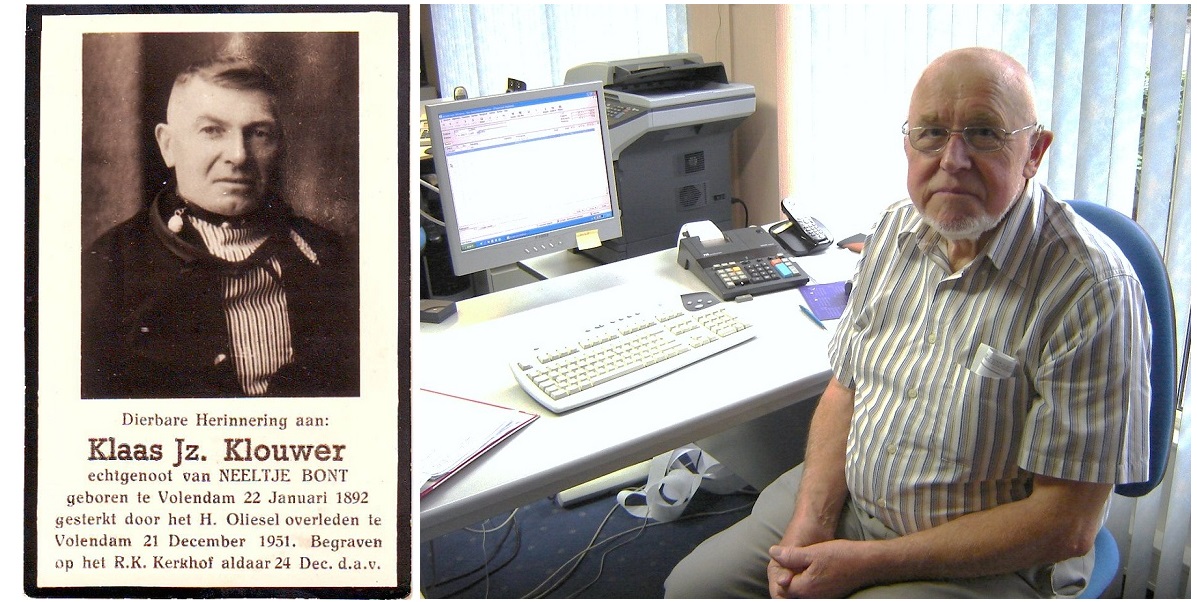
POW and seven men died.
The three USAAF lieutenants Cripe, Anderson and Dallacqua (names unknown at the time) were taken by the Germans to Amsterdam. Here they were held four days in prison Weteringschans and undergone their first interrogation. Subsequently they were taken by train to Germany, to an intermediate prison for further questioning. This was in Oberursel, a few miles north of Frankfurt am Main at the famous 'Auswertestelle West': the Luftwaffe Evaluation Center where the interrogators spoke perfect English (recommended book on this: 'The Interrogator, the story of Hanns Scharff, Luftwaffe's Master Interrogator'. By Raymond F. Toliver, USA, 1978). Hubert Cripe was (later) asked here if he knew 'Woder'. This was his belly turret gunner S/Sgt. Gerard B. Yoder, whose body had been recovered in the water near the crash location at Marken Island end of April 1944 and was buried in Amsterdam on 6 May 1944. It was hard for Lt. Cripe to learn that seven of his crew died, something he carried with him for the rest of his life. Freedom is not for free.
On the dike in Volendam.
Fishermen Jaap and his youngest brother Klaas Bol were accusted of 'Feindbegünstigung' and more. They had made a run from the scene with their boat and the airmen were in civilian overclothes, tucked away in the beds on board, obviously with intention to get them to the resistance and on a pilot escapeline. On the dike at (now) Bar de Molen the fishermen had to sit on the street under guard, waiting for transport to Amsterdam. "You are going to Westerbork", said the angry German police boat officer. That was not good news, Westerbork was a Dutch Durchgangslager (passing-through camp) that led to death- and slave workcamps in Germany, usually to camp Neuengamme near Hamburg. At some point the men were allowed to go to their homes for one hour, to fill a duffel bag with clothes and other things they would need.
Walking down the road, Jaap and Klaas Bol did not spoke a word to each other. Klaas knew he had made the proper decision changing course and save lives, but what happened now was exactly what his skipper/oldest brother warned him for... The author's father witnessed when Klaas Bol came from the stairs with his filled duffel bag, walked out of his house (Kathammerstraat no. 74) and said nothing. "Where are you going!", shouted my grandmother Hille Bond. He said: "I have to do something" and left.
On the dike a crowd formed around the two fishermen that were waiting for the German truck, Klaas numb, Jaap eyes closed and praying silently. Burgomaster van Baar arrived. Relentlessly he kept on talking to the German officer, because they only had done what everybody would have done in this situation, it could have been German pilots! The truck did not arrive and after a hour the German officer released his two captives. Jaap and Klaas never talked about the incident for the rest of their lives. We had to learn the story from eyewitnesses Hans Kes and Klaas Drop in 2009, surprised that our grandfathers never mentioned it to us, despite the fact they knew we were researching the Airwar over the Lake since 1996...
Post war enquiry
After the war (January 1946) an article in the Dutch newspaper asked anyone to report knowledge or experience with downed aircraft, bodies found and pilot help. Jaap Kwakman (VD67) and Klaas Klouwer (VD106) wrote back but the matter remained unsolved. It could not be established who the rescued airmen had been. Jaap (Jacob) Kwakman and Klaas (Nicolaas) Klouwer are on below apply-list for the 'Eisenhower Certificate' for pilot help, but due to the lack of facts and names, result was 'Nil' = Denied, see below list.

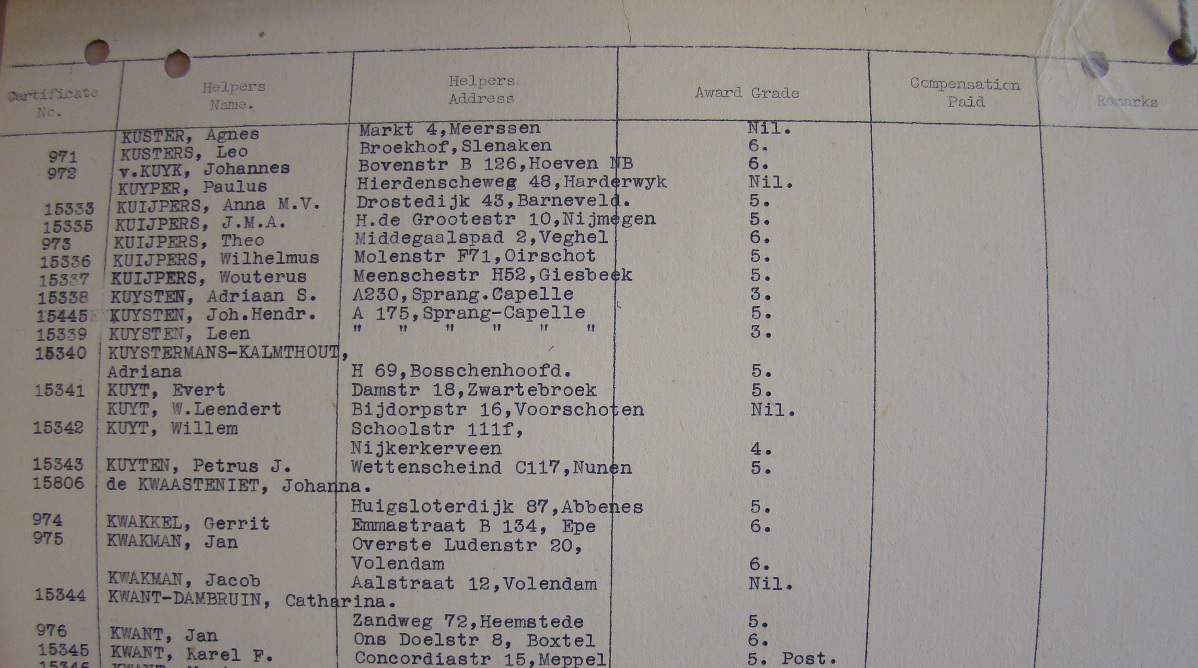
The post war statement (Jan. 1946) of skippers Jaap (Jacob) Kwakman and Klaas Klouwer (from the US National Archives, Maryland).

Skipper's statement January 1946, in Dutch. From the National Archives 'Dutch Helpers File' (text of original handwritten letter in the file):
"Na wat ik in de courant gelezen heb van 3 jan. j.l. weet ik niet of wij daar ook onder bedoeld worden, maar ik wou toch uit aardigheid het volgende onder uw aandacht brengen, wat wij met dat zoodje gespuis meegemaakt hebben.
Wij varen met de botter mijn zwager en wij 6 maart 1944 naar de haven van Volendam en toen wij een uur te gaans waren, zagen wij een brandend vliegtuig naar beneden komen met een stuk of 6 of 7 parachutisten eruit vallen, die niet ver van ons af vielen. Zonder na te denken stoomden wij er heen en haalden tot onze voldoening 2 levenden menschen binnen boord, waarvan de tweede al niet veel meer in de melk had te brokken, maar wij ontdeden hun vlug van hun krappe natte kleren en lagen hun toe in onze kooi, maakten toen een bakje koffie klaar en gaven hen toen een sigaar waar zij erg blij mee waren. Toen zij wat bijgekomen waren, wilden wij wat met hun praten, maar konden helaas niet anders van hen te weten komen dan dat zij Amerikanen waren, waarvan er 1 officier was.
Er lag een Duitse boot in onze naaste omgeving, maar daar wij die mensen niet aan de Duitsers wilden afgeven, hadden wij rechtstreeks koers gezet op Volendam aan. Hierna waren wij met die mensen bezig hun kleren te drogen en mijn zoon stond aan het roer en zei toen: 'Vader, er komt een andere Duitse boot ons achterop'. Ik zei toen 'hou jij maar koers op Volendam aan, zoo lang als hij maar niet op de hoorn begint te blazen'. Maar jawel hoor, even later begon dat monster te blazen, waarop wij hem toen wachtte. Toen hij nog niet eens langzij lag sprong er al een Duitser over bij ons en zijn eerste woord was: 'jij en jij' en wees met mijn vinger op mij en m'n knecht; 'de kogel' en riep meteen een andere Duitser aan die op ons de wacht moest houden, daar hij anders zeker bang was dat wij overboord zouden springen. Hij ging naar beneden en trok die mensen uit de kooi en moesten naakt met een losse jas over hen heen zoo over in de Duitse boot. Een van de twee deed nog met zijn hand naar ons wuiven maar werd als een beest weggetrapt. En wij zouden er zei hij wel meer van horen, wat wij niet gehoord hebben.
De namen van die mensen hebben wij door zenuwachtigheid niet bekeken op hun plaatje op hun borst. Mijn zwager echter, die er 1 gered had, en ook aan de Duitser afgeven moest, heeft dat plaatje wel bekeken, waarop stond: C.D. Miller. Of dat nou zijn naam was, ik zou denken van wel. Ik had gehoopt dat wij na de bevrijding weleens wat van die menschen gehoord hadden, maar helaas neen. Zouden die menschen nog in leven zijn? Ik voor mij vrees het ergste. Het waren 2 mensen die wij gered hebben ik denk van ongeveer 30 en 35 jaar. Mocht U aan dit schrijven niets hebben, hoop ik dat U het mij niet kwalijk zult nemen".
Hoogachtend, J. Kwakman, Aalstraat 12 & Nicolaas Klouwer, Meergracht, Volendam.

Skipper's statement, translated in English:
"After what I have read in the newspaper of 8 Jan 1946, don't know if we qualify for this as well (1), but I would like to bring to your attention a nice story we have including an encounter with that bunch of crooks (2). We were sailing with the Botter (3), my brother-in-law and us (4) on the 6th of March 1944. An hour off the Volendam harbor we saw a burning aircraft coming down with some 6 or 7 parachutes that were falling out of it, not far from us. Without thinking we steamed to them and hauled to our satisfaction two men aboard alive, one of them was weak and could hardly speak. We removed their tight, wet clothes and put them in our bunk-beds, made some coffee and gave them a cigar which they liked very much. After regaining their senses, we liked to start a conversation (5), but could not learn more of them that they were Americans, one of them was an officer.
A German boat lay in our surroundings, but because we did not want to hand over these men to the Germans, we headed strait for Volendam. Thereafter we were drying their clothes, my son (6) was standing at the helm and said 'father, another German boat is running up to us from the rear'. I said 'you just keep course on Volendam, as long as he does not blow his horn'. But sure enough, moments later the monster blew his horn, we stopped and waited. He was not fully alongside with us, when already a German jumped over. His first words were: 'you and you' and pointed with his finger to me and my helper: 'the bullet'. He ordered another German to guard us, maybe he was affraid we would jump overboard. Then he went down en pulled those men from the bunks, threw them in the German boat, naked with only an overcoat hanging loose over them. One of the two made a hand wave gesture to us, but was kicked away as a beast. We would hear more on the consequenses, but nothing heard since then.
The names of the men were not recorded from their dog-tags on their chest, because of the excitement. My brother-in-law however, who also saved one (7) and also had to hand him over to the Germans, did take a look at the tag, it read 'C.D. Miller' (8). Don't know if this was his name, one should think so. I hoped that after liberation they would have made contact, but regrettably no. Would they have survived? To me, I fear the worst. The two men we saved were I believe 30 to 35 years old (9). Should this letter not be of any use to you, then I hope you don't blame me for sending it".
Yours truly, J. Kwakman, Aalstraat 12 (Eel-street no. 12) & Nicolaas Klouwer, Meergracht, Volendam.
------------------
Notes in above statement:
(1) Qualify for the Eisenhower Certificate for helping Allied Personnel in WW2.
(2) Crooks: the scum of the Waffen-SS manning the German patrol boats.
(3) Botter. Traditional wooden Zuyder Sea fishing ship (as seen on the images).
(4) Brother-in-law Nicolaas Klouwer on the VD106 and Jaap (Jacob) Kwakman on the VD67.
(5) Little conversation was possible because the fishermen did not spoke English.
(6) Jaap's son, the then 14 year old Klaas Kwakman 'Drop'.
(7) Brother-in-law Nicolaas Klouwer rescued navigator Homer 'Spike' Dallacqua.
(8) Eyewitness Hans Kes states skipper Klouwer looked in Dallacqua's wallet, not on his dog tag.
'C.D. Miller' probably refers to Dallacqua's commanding officer (C.O.) Colonel Miller.
Colonel J. A. Miller, commander of the 453 BG, went down himself in 41-28469 on 18 March 1944.
(9) Hubert Cripe and Russell Anderson were born in 1920 and were age 24.
Despite the completed questionaire (above), it remained unknown who the rescued airmen had been. The thanks from Allied side remained nil.
--------------------------------------------------------------------
Recovery of the dead.
Mid April 1944, six weeks after the crash, the missing crew were recovered from the water. Four bodies were found near Volendam. Below photo shows the coffins of bombardier 2Lt. Maurice A. Dinneen and engineer T/Sgt. Mack O. Garret in Volendam harbor on the old slipway (Ouwe Helling). Together with Sgt. William Chapell and and Sgt. Gerald Yoder they were buried in Amsterdam. Three men, Sgt. Edgett, Sgt. Keefe and Sgt. McGue (August 1944) were buried resp. in Harderwijk and Amersfoort (via Bunschoten).
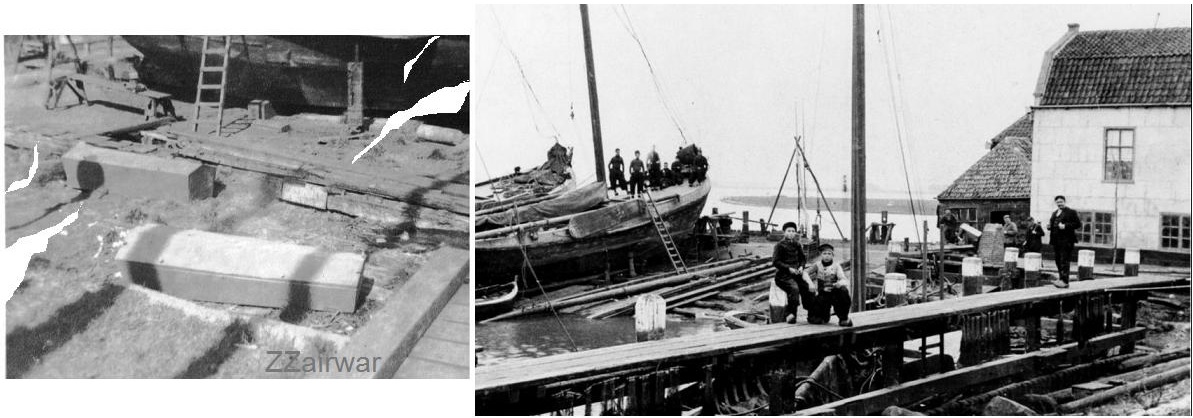
=======================
Image below. The other USAAF crashes (only the west side of Berlin) on the 6 March 1944 Berlin-Genshagen attack (orange crosses), a costly raid.
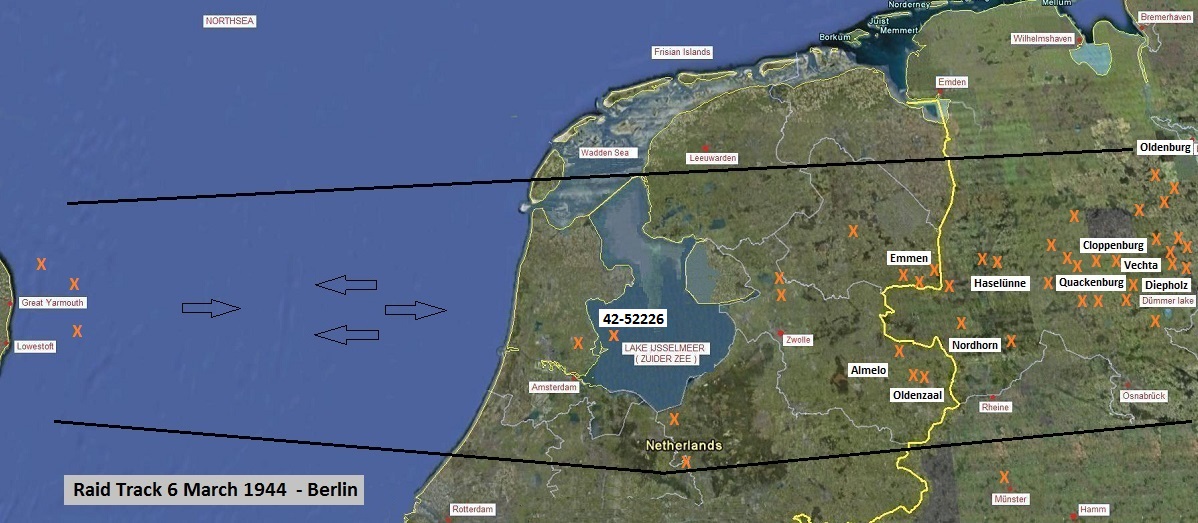
Below. Crash position 6 March 2018, ice.
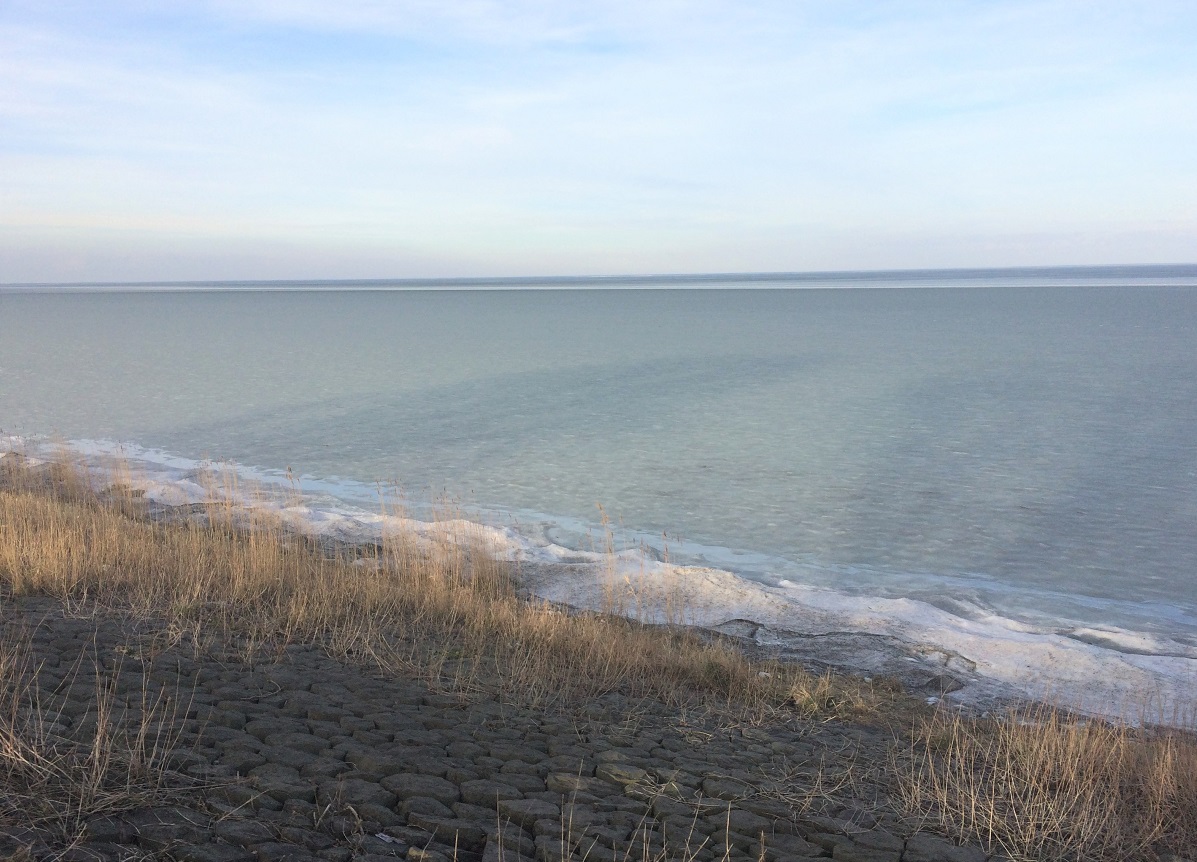
=============================================================
The VD67 and VD106 after March 6 1944.
All catch had to be sold to the Germans for little money, so they decided to sell or trade as much as possible onto the black market to get money or trade goods to support the family and neighbors. The VD18 (skipper de Gokker), VD67 (Kwakman) and VD106 (Klouwer) came in contact with a young man in Muiden (Gerrit Verwelius) who could take the fish from them and smuggle it during dark nights into Muiden. Klaas Kwakman: "we went in the darkness to the Muiden-coast. Not with two boats, always with one and with the youngest men on that boat. If they got caught, we always had one ship behind and could support the families who were without father".
Smuggler Gerrit Verwelius: "at night they were always on time. In the pitch dark I gave a signal with my flashlight and after making contact I rowed in my small rowboat towards them to collect the fish. Sometimes there was so much eel, more than 1000 pounds, that I had to swim alongside my eel-filled rowboat and tow it to the coast. I became black market wholesaler in eel in 't Gooi".
Photo below: After the war Gerrit Verwelius returned regulary to Volendam and visited Jaap Kwakman's family (mother of Nel Bol next to Gerrit Verwelius).
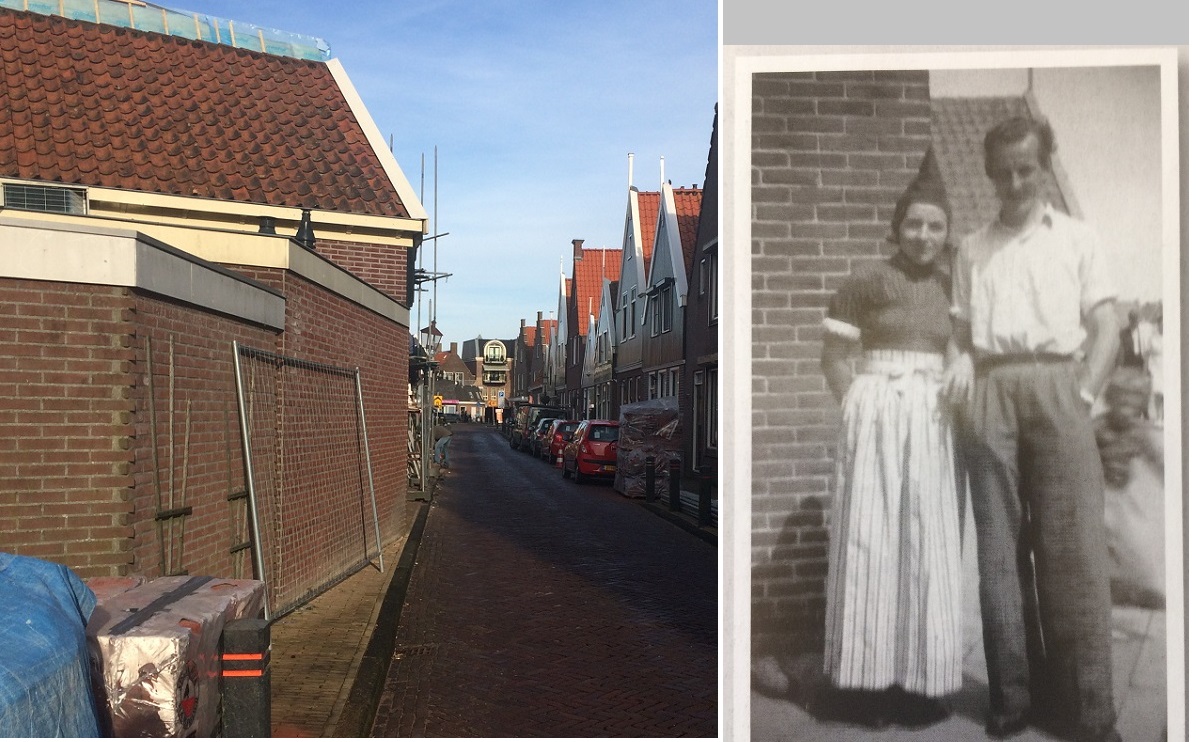
Photos below. The 'Pieper Race' (the Potato Race). Hunger winter December 1944 - April 1945.
In winter december 1944 and begin 1945 there was no more food left in Holland. The German occupation force left the people to starve. Bishop Sijmen Mol (born in Volendam) who was bishop in Amsterdam, arranged with the Germans that fishing boats were allowed to cross the Lake unhindered by the German patrol boats to get potatoes from the Dutch province of Friesland, where there were still potatoes left in storages at farmers. With these potatoes sailed over to Amsterdam, the hospitals could be kept open. It was a race to prevent starvation. After the war Sijmen Mol received a bronze potatoe as commemorative trophy (photo below left). The photo right shows the VD18 and VD67 with potatoes in Friesland, Feb. 1945, Joure canal.
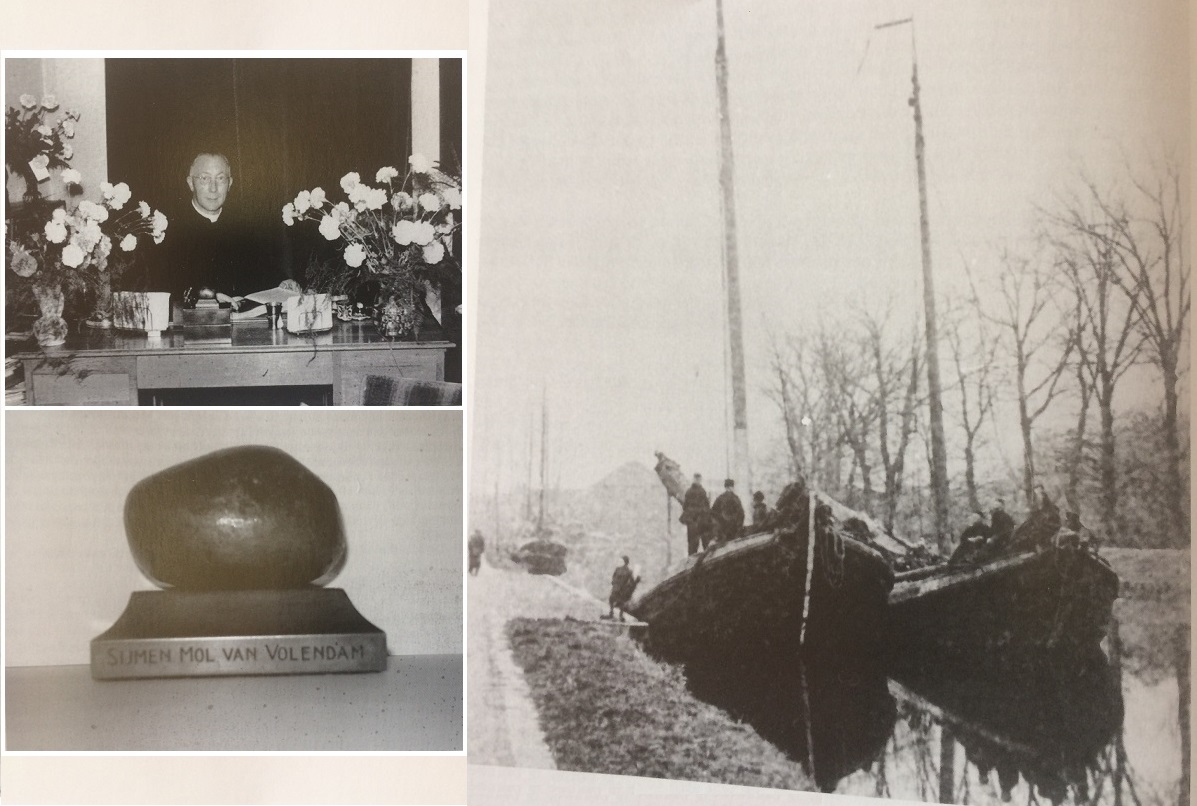
Photo below. Our best family photo ever.
De Gokker and Kwakman-Bol family alongside their boats, Pieper Race, Joure Friesland, WW2, February 1945. Gerrit Verwelius is also in the photo. He had to escape Muiden and kept in hiding on the VD67, dressed as Volendammer until the end of the war. Later he became a succesful building contracter. Notice how the boat is filled with potatoes to the rim. They had to walk over the cargo on planks. On the potatoes is also a crate for the food and drinks on board ('viktualien kist') and a bicycle. Two German soldiers are in the background.
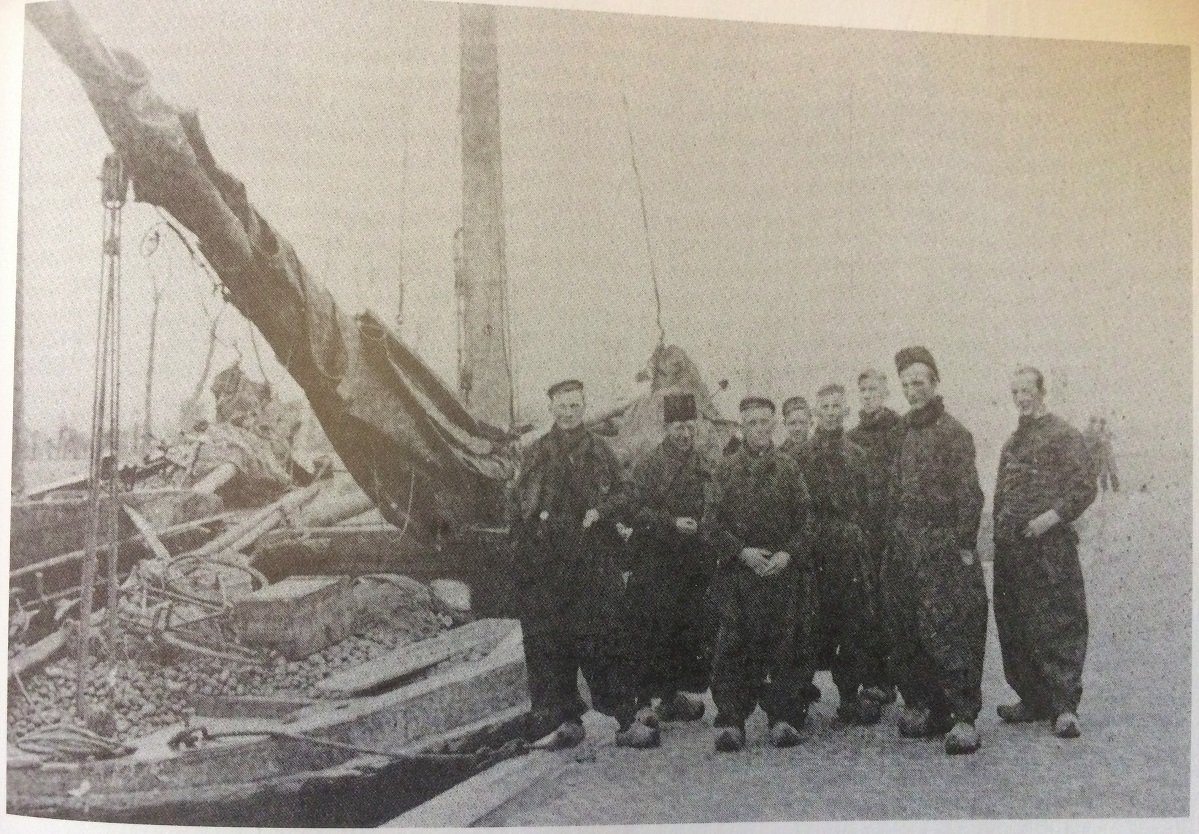
In de jaren 1950-70 hield Jaap Kwakman zich bezig met netten boeten op de zolder van z'n huis. Zijn zusters zaten vaak bij elkaar aan de eettafel met het plastic tafelkleed.
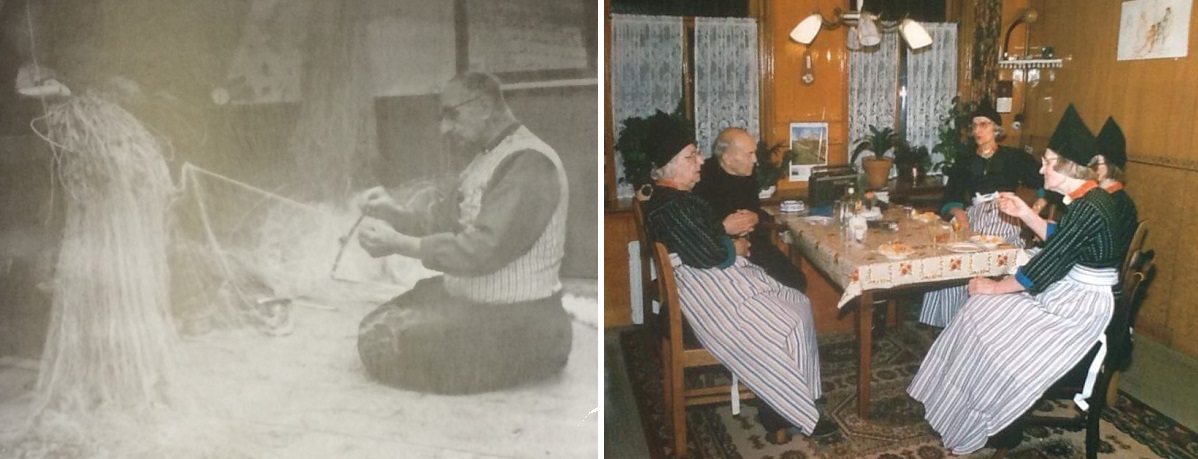
Onder. Jaap Kwakman en Anton Heyboer.
Op een dag kwam Anton Heyboer langs het raam van Jaap's zusters. Net als zovelen kwam hij binnen voor een koppie en een ouwehoertje. Hij had het naar z'n zin en ging niet meer weg. Om de paar dagen was hij terug. Jaap vond het maar een rare snoeshaan en moest niets van hem hebben. De zusters inclusief pietje Gaar (Geertje) vonden die grappige kunstenaar wel interessant. Zoon Klaas Drop: "tot op een zondag Jaap in de kerk zijn zusters miste, dat was nog nooit gebeurd... Na de kerk stoomde hij op het huis van z'n zusters aan. Daar zaten ze aan de tafel te lachen met weer die vreemde praatjesmaker. Heyboer had ook nog in de kasten wezen skarrele en had Jaap's ouwe Volendammer bottergoed aan... Jaap's handen waren twee keer groter dan een normaal mens en die schoppen pakten Heyboer bij z'n lurven. Jaap smeet Heyboer in een boog door de lucht de straat over, tegen de muur van de overbuurman (de muur van foto boven, met Nel Bol's moeder en Gerrit Verwelius). 'Nooit mear verrom komme', zei Jaap. 'En dat pak ke je ouwe". Zo is Anton Heyboer aan z'n Volendammer pak gekomen. Hij droeg het nog vaak op TV.
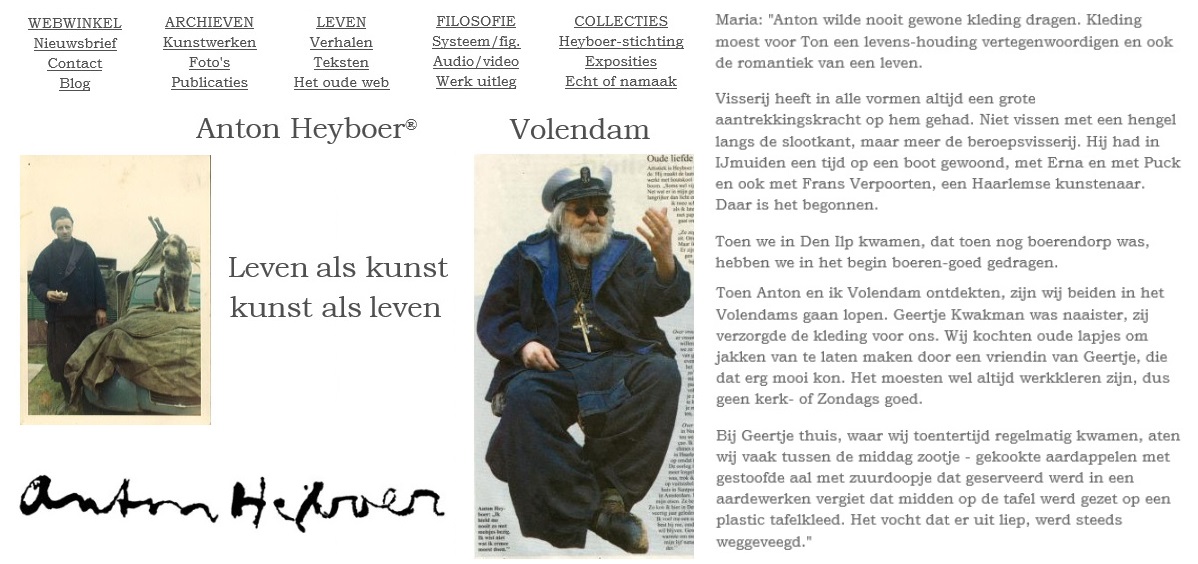
==
Thanks to/read more:
- Mr. Hubert R. Cripe and Mrs. Tina Fleming
- Mr. Hans Kes and Mr. Klaas Kwakman
- Website 453 Bomb Group - http://www.453rd.com/
- Website Escape lines in Netherlands WW2- https://wwii-netherlands-escape-lines.com/
- Book 'Wereldoorlog in het dorp, Volendam'. By Piet and Evert Koning, 2010.
- The Veterans History Project, Library of Congress (video interview 2011) - http://memory.loc.gov/diglib/vhp/story/loc.natlib.afc2001001.91409/
- MACR
- Adventure, Sports, Outdoor. ASO (video interview youtube with H.Cripe, 2015) - https://www.youtube.com/watch?v=KsEGboXYYVo
- Original Amsterdam burial files WW2
- T/Sgt. Mack O. Garret https://www.fieldsofhonor-database.com/index.php/en/american-war-cemetery-margraten-g/57063-garrett-mack-o
- The National Archives, College Park, MD.
- Book 'An Emotional Gauntlet' (from life in peacetime America to the War in European Skies), by Stuart J. Wright, 2004.
© ZZairwar (Zuyder Zee Air War)
.